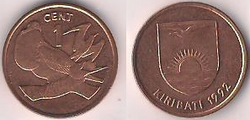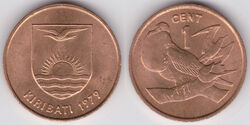mNo edit summary Tag: sourceedit |
Tag: apiedit |
||
| Line 12: | Line 12: | ||
|shape= round |
|shape= round |
||
|alignment= [[medallic alignment|medallic]] |
|alignment= [[medallic alignment|medallic]] |
||
| − | |obverse= |
+ | |obverse= {{wp|en|Coat of arms of Kiribati}}, state title, year |
| − | |reverse= |
+ | |reverse= {{wp|en|Great Frigatebird}} ([[wikispecies:Fregata minor|''Fregata minor'']]), value |
}} |
}} |
||
The '''1 [[cent]] [[coin]]''' is a [[circulation]] coin of the [[Kiribati|Republic of Kiribati]] that was produced by the [[Royal Australian Mint]] during [[1979]], the year of the country's independence, and [[1992]]. The coin has a value equivalent to 0.01 [[Kiribati dollars]], thus making it also equal in value to 0.01 [[Australian dollar]]s due to a [[currency peg]]. It is the lowest-denominated piece of currency ever issued by Kiribati, and although it is still [[legal tender]], [[devaluation]] has effectively rendered it obsolete. Both sides were designed by [[United Kingdom|British]] sculptor [[Michael Hibbit]] (1947–). |
The '''1 [[cent]] [[coin]]''' is a [[circulation]] coin of the [[Kiribati|Republic of Kiribati]] that was produced by the [[Royal Australian Mint]] during [[1979]], the year of the country's independence, and [[1992]]. The coin has a value equivalent to 0.01 [[Kiribati dollars]], thus making it also equal in value to 0.01 [[Australian dollar]]s due to a [[currency peg]]. It is the lowest-denominated piece of currency ever issued by Kiribati, and although it is still [[legal tender]], [[devaluation]] has effectively rendered it obsolete. Both sides were designed by [[United Kingdom|British]] sculptor [[Michael Hibbit]] (1947–). |
||
| − | The pieces produced in [[1979]] and some of those minted in [[1992]] are composed of [[bronze]], while the majority of the 1992 coins are made of bronze-plated [[steel]]. Despite the differences in composition, both the bronze and bronze-plated steel varieties of the Kiribati cent, as well as the [[Australian 1 cent coin|Australian coin]] of the same denomination, share a mass of 2.6 grams and a diameter of 17.5 millimeters. The two are also round in [[shape]] and have [[medallic alignment]] and smooth [[edge]]s. Featured at the top center of both coins' [[obverse]]s is the |
+ | The pieces produced in [[1979]] and some of those minted in [[1992]] are composed of [[bronze]], while the majority of the 1992 coins are made of bronze-plated [[steel]]. Despite the differences in composition, both the bronze and bronze-plated steel varieties of the Kiribati cent, as well as the [[Australian 1 cent coin|Australian coin]] of the same denomination, share a mass of 2.6 grams and a diameter of 17.5 millimeters. The two are also round in [[shape]] and have [[medallic alignment]] and smooth [[edge]]s. Featured at the top center of both coins' [[obverse]]s is the {{wp|en|coat of arms of Kiribati}} — which features inside an {{wp|en|Escutcheon (heraldry)|escutcheon}} a depiction of a {{wp|en|frigatebird}} in flight over a rising {{wp|en|sun}} and the {{wp|en|Pacific Ocean}}. The state title "KIRIBATI" is arched around the rim below the arms, and is followed by the date of minting. Depicted on the [[reverse]] of both coins are two {{wp|en|Great Frigatebird|Great Frigatebirds}} (''[[wikispecies:Fregata minor|Fregata minor]]''), one perched on a {{wp|en|tree}} limb and another in flight. The value is printed at the very top of both coins as "CENT 1", the word and the numeral printed on separate lines and the latter being much larger than the former. |
| − | [[Krause Publications|Krause]]'s ''[[Standard Catalog of World Coins]]'' currently lists the bronze and bronze-plated steel coins as different types. Even though both types of the year 1992 are identical in design and measurements, the bronze-plated steel coins can often be distinguished from their attraction to |
+ | [[Krause Publications|Krause]]'s ''[[Standard Catalog of World Coins]]'' currently lists the bronze and bronze-plated steel coins as different types. Even though both types of the year 1992 are identical in design and measurements, the bronze-plated steel coins can often be distinguished from their attraction to {{wp|en|Magnet|magnets}} and their generally noticeable luster. A reported total of approximately 100,000 bronze pieces were minted in 1979: 90,000 circulation and 10,000 [[proof coin]]s. The [[mintage]]s of the bronze and bronze-plated steel pieces of 1992 are currently unknown, but the number of plated examples in existence is believed to exceed that of its bronze counterpart. |
==References== |
==References== |
||
Revision as of 23:50, 10 March 2016
| 1 cent | |
|---|---|
| General information | |
| Country | |
| Value |
$0.01 |
| Years |
1979–1992 |
| Measurements and composition | |
| Mass |
2.6 g |
| Diameter |
17.5 mm |
| Composition |
|
| Appearance | |
| Shape |
round |
| Alignment |
medallic |
| Obverse |
Coat of arms of Kiribati, state title, year |
| Reverse |
Great Frigatebird (Fregata minor), value |
| v · d · e | |
The 1 cent coin is a circulation coin of the Republic of Kiribati that was produced by the Royal Australian Mint during 1979, the year of the country's independence, and 1992. The coin has a value equivalent to 0.01 Kiribati dollars, thus making it also equal in value to 0.01 Australian dollars due to a currency peg. It is the lowest-denominated piece of currency ever issued by Kiribati, and although it is still legal tender, devaluation has effectively rendered it obsolete. Both sides were designed by British sculptor Michael Hibbit (1947–).
The pieces produced in 1979 and some of those minted in 1992 are composed of bronze, while the majority of the 1992 coins are made of bronze-plated steel. Despite the differences in composition, both the bronze and bronze-plated steel varieties of the Kiribati cent, as well as the Australian coin of the same denomination, share a mass of 2.6 grams and a diameter of 17.5 millimeters. The two are also round in shape and have medallic alignment and smooth edges. Featured at the top center of both coins' obverses is the coat of arms of Kiribati — which features inside an escutcheon a depiction of a frigatebird in flight over a rising sun and the Pacific Ocean. The state title "KIRIBATI" is arched around the rim below the arms, and is followed by the date of minting. Depicted on the reverse of both coins are two Great Frigatebirds (Fregata minor), one perched on a tree limb and another in flight. The value is printed at the very top of both coins as "CENT 1", the word and the numeral printed on separate lines and the latter being much larger than the former.
Krause's Standard Catalog of World Coins currently lists the bronze and bronze-plated steel coins as different types. Even though both types of the year 1992 are identical in design and measurements, the bronze-plated steel coins can often be distinguished from their attraction to magnets and their generally noticeable luster. A reported total of approximately 100,000 bronze pieces were minted in 1979: 90,000 circulation and 10,000 proof coins. The mintages of the bronze and bronze-plated steel pieces of 1992 are currently unknown, but the number of plated examples in existence is believed to exceed that of its bronze counterpart.
References
| Kiribati dollar | |
|---|---|
| Coins | 1¢ • 2¢ • 5¢ • 10¢ • 20¢ • 50¢ • $1 • $2 • $5 • $10 • $20 • $50 • $100 • $150 • $200 • $500 |
| Miscellaneous | Australian dollar • Cent • Dollar • Fixed exchange rate • Michael Hibbit • Royal Australian Mint |


